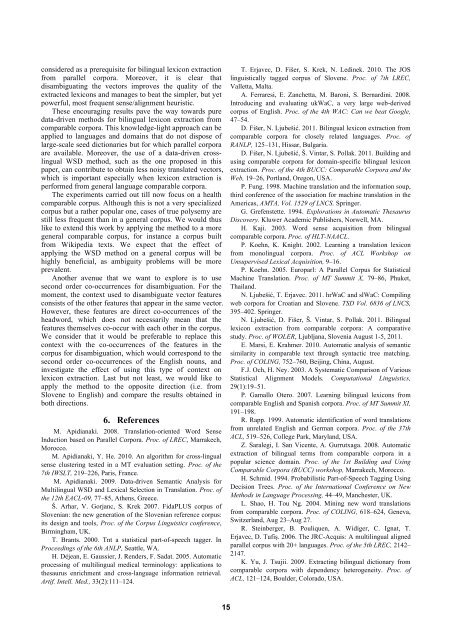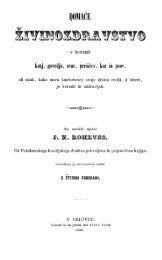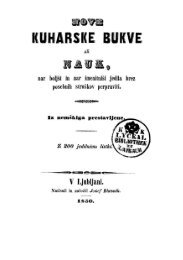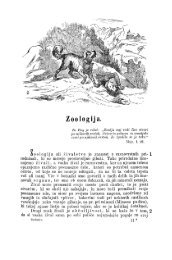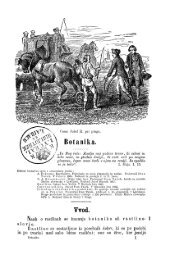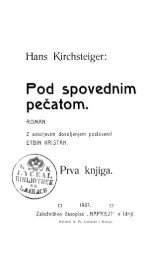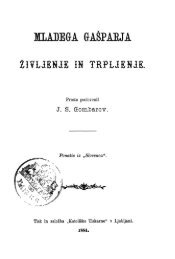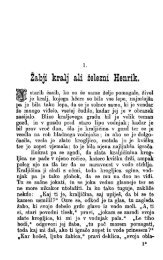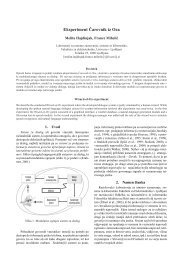Proceedings - Natural Language Server - IJS
Proceedings - Natural Language Server - IJS
Proceedings - Natural Language Server - IJS
You also want an ePaper? Increase the reach of your titles
YUMPU automatically turns print PDFs into web optimized ePapers that Google loves.
considered as a prerequisite for bilingual lexicon extraction<br />
from parallel corpora. Moreover, it is clear that<br />
disambiguating the vectors improves the quality of the<br />
extracted lexicons and manages to beat the simpler, but yet<br />
powerful, most frequent sense/alignment heuristic.<br />
These encouraging results pave the way towards pure<br />
data-driven methods for bilingual lexicon extraction from<br />
comparable corpora. This knowledge-light approach can be<br />
applied to languages and domains that do not dispose of<br />
large-scale seed dictionaries but for which parallel corpora<br />
are available. Moreover, the use of a data-driven crosslingual<br />
WSD method, such as the one proposed in this<br />
paper, can contribute to obtain less noisy translated vectors,<br />
which is important especially when lexicon extraction is<br />
performed from general language comparable corpora.<br />
The experiments carried out till now focus on a health<br />
comparable corpus. Although this is not a very specialized<br />
corpus but a rather popular one, cases of true polysemy are<br />
still less frequent than in a general corpus. We would thus<br />
like to extend this work by applying the method to a more<br />
general comparable corpus, for instance a corpus built<br />
from Wikipedia texts. We expect that the effect of<br />
applying the WSD method on a general corpus will be<br />
highly beneficial, as ambiguity problems will be more<br />
prevalent.<br />
Another avenue that we want to explore is to use<br />
second order co-occurrences for disambiguation. For the<br />
moment, the context used to disambiguate vector features<br />
consists of the other features that appear in the same vector.<br />
However, these features are direct co-occurrences of the<br />
headword, which does not necessarily mean that the<br />
features themselves co-occur with each other in the corpus.<br />
We consider that it would be preferable to replace this<br />
context with the co-occurrences of the features in the<br />
corpus for disambiguation, which would correspond to the<br />
second order co-occurrences of the English nouns, and<br />
investigate the effect of using this type of context on<br />
lexicon extraction. Last but not least, we would like to<br />
apply the method to the opposite direction (i.e. from<br />
Slovene to English) and compare the results obtained in<br />
both directions.<br />
6. References<br />
M. Apidianaki. 2008. Translation-oriented Word Sense<br />
Induction based on Parallel Corpora. Proc. of LREC, Marrakech,<br />
Morocco.<br />
M. Apidianaki, Y. He. 2010. An algorithm for cross-lingual<br />
sense clustering tested in a MT evaluation setting. Proc. of the<br />
7th IWSLT, 219–226, Paris, France.<br />
M. Apidianaki. 2009. Data-driven Semantic Analysis for<br />
Multilingual WSD and Lexical Selection in Translation. Proc. of<br />
the 12th EACL-09, 77–85, Athens, Greece.<br />
Š. Arhar, V. Gorjanc, S. Krek 2007. FidaPLUS corpus of<br />
Slovenian: the new generation of the Slovenian reference corpus:<br />
its design and tools, Proc. of the Corpus Linguistics conference,<br />
Birmingham, UK.<br />
T. Brants. 2000. Tnt a statistical part-of-speech tagger. In<br />
<strong>Proceedings</strong> of the 6th ANLP, Seattle, WA.<br />
H. Déjean, E. Gaussier, J. Renders, F. Sadat. 2005. Automatic<br />
processing of multilingual medical terminology: applications to<br />
thesaurus enrichment and cross-language information retrieval.<br />
Artif. Intell. Med., 33(2):111–124.<br />
15<br />
T. Erjavec, D. Fišer, S. Krek, N. Ledinek. 2010. The JOS<br />
linguistically tagged corpus of Slovene. Proc. of 7th LREC,<br />
Valletta, Malta.<br />
A. Ferraresi, E. Zanchetta, M. Baroni, S. Bernardini. 2008.<br />
Introducing and evaluating ukWaC, a very large web-derived<br />
corpus of English. Proc. of the 4th WAC: Can we beat Google,<br />
47–54.<br />
D. Fišer, N. Ljubešić. 2011. Bilingual lexicon extraction from<br />
comparable corpora for closely related languages. Proc. of<br />
RANLP, 125–131, Hissar, Bulgaria.<br />
D. Fišer, N. Ljubešić,Š. Vintar, S. Pollak. 2011. Building and<br />
using comparable corpora for domain-specific bilingual lexicon<br />
extraction. Proc. of the 4th BUCC: Comparable Corpora and the<br />
Web, 19–26, Portland, Oregon, USA.<br />
P. Fung. 1998. Machine translation and the information soup,<br />
third conference of the association for machine translation in the<br />
Americas, AMTA, Vol. 1529 of LNCS. Springer.<br />
G. Grefenstette. 1994. Explorations in Automatic Thesaurus<br />
Discovery. Kluwer Academic Publishers, Norwell, MA.<br />
H. Kaji. 2003. Word sense acquisition from bilingual<br />
comparable corpora. Proc. of HLT-NAACL.<br />
P. Koehn, K. Knight. 2002. Learning a translation lexicon<br />
from monolingual corpora. Proc. of ACL Workshop on<br />
Unsupervised Lexical Acquisition, 9–16.<br />
P. Koehn. 2005. Europarl: A Parallel Corpus for Statistical<br />
Machine Translation. Proc. of MT Summit X, 79–86, Phuket,<br />
Thailand.<br />
N. Ljubešić, T. Erjavec. 2011. hrWaC and slWaC: Compiling<br />
web corpora for Croatian and Slovene. TSD Vol. 6836 of LNCS,<br />
395–402. Springer.<br />
N. Ljubešić, D. Fišer, Š. Vintar, S. Pollak. 2011. Bilingual<br />
lexicon extraction from comparable corpora: A comparative<br />
study. Proc. of WOLER, Ljubljana, Slovenia August 1-5, 2011.<br />
E. Marsi, E. Krahmer. 2010. Automatic analysis of semantic<br />
similarity in comparable text through syntactic tree matching.<br />
Proc. of COLING, 752–760, Beijing, China, August.<br />
F.J. Och, H. Ney. 2003. A Systematic Comparison of Various<br />
Statistical Alignment Models. Computational Linguistics,<br />
29(1):19–51.<br />
P. Gamallo Otero. 2007. Learning bilingual lexicons from<br />
comparable English and Spanish corpora. Proc. of MT Summit XI,<br />
191–198.<br />
R. Rapp. 1999. Automatic identification of word translations<br />
from unrelated English and German corpora. Proc. of the 37th<br />
ACL, 519–526, College Park, Maryland, USA.<br />
Z. Saralegi, I. San Vicente, A. Gurrutxaga. 2008. Automatic<br />
extraction of bilingual terms from comparable corpora in a<br />
popular science domain. Proc. of the 1st Building and Using<br />
Comparable Corpora (BUCC) workshop, Marrakech, Morocco.<br />
H. Schmid. 1994. Probabilistic Part-of-Speech Tagging Using<br />
Decision Trees. Proc. of the International Conference on New<br />
Methods in <strong>Language</strong> Processing, 44–49, Manchester, UK.<br />
L. Shao, H. Tou Ng. 2004. Mining new word translations<br />
from comparable corpora. Proc. of COLING, 618–624, Geneva,<br />
Switzerland, Aug 23–Aug 27.<br />
R. Steinberger, B. Pouliquen, A. Widiger, C. Ignat, T.<br />
Erjavec, D. Tufiş. 2006. The JRC-Acquis: A multilingual aligned<br />
parallel corpus with 20+ languages. Proc. of the 5th LREC, 2142–<br />
2147.<br />
K. Yu, J. Tsujii. 2009. Extracting bilingual dictionary from<br />
comparable corpora with dependency heterogeneity. Proc. of<br />
ACL, 121–124, Boulder, Colorado, USA.


